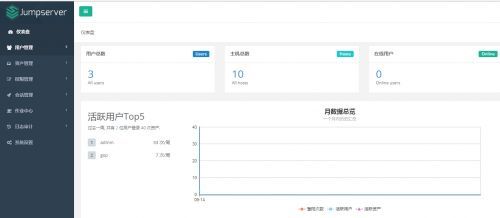
JumpServer堡垒机详细安装文档
环境:
[root@node10 ~]# uname -a
Linux node10 2.6.32-696.el6.x86_64 #1 SMP Tue Mar 2119:29:05 UTC 2017 x86_64 x86_64 x86_64 GNU/Linux
[root@node10 ~]# cat /etc/redhat-release
CentOS release 6.9 (Final)
[root@node11 ~]# mysql --version
mysql Ver 14.14Distrib 5.7.18, for Linux (x86_64) using EditLine wrapper
本文档旨在帮助用户了解各组件之间的关系,如果已经接触过之前的版本,可参考 进阶安装文档
安装过程中遇到问题可参考 安装过程中常见的问题
测试推荐硬件
· CPU: 64位双核处理器
· 内存: 4G DDR3
环境
· 系统: CentOS 7
· IP: 192.168.244.144
· 关闭 selinux 和防火墙
# CentOS 7
$ setenforce 0 # 临时关闭,重启后失效
$ systemctl stop firewalld.service # 临时关闭,重启后失效
# 修改字符集,否则可能报 input/outputerror的问题,因为日志里打印了中文
$ localedef -c -f UTF-8 -i zh_CNzh_CN.UTF-8
$ export LC_ALL=zh_CN.UTF-8
$ echo 'LANG="zh_CN.UTF-8"' >/etc/locale.conf
# CentOS6
$ setenforce 0 # 临时关闭,重启后失效
$ service iptables stop # 临时关闭,重启后失效
# 修改字符集,否则可能报 input/outputerror的问题,因为日志里打印了中文
$ localedef -c -f UTF-8 -i zh_CNzh_CN.UTF-8
$ export LC_ALL=zh_CN.UTF-8
$ echo 'LANG=zh_CN.UTF-8' >/etc/sysconfig/i18n
一. 准备 Python3 和 Python 虚拟环境
1.1 安装依赖包
$ yum -y install wget sqlite-devel xz gccautomake zlib-devel openssl-devel epel-release git lrzsz
Yum 加速设置请参考 <http://mirrors.163.com/.help/centos.html>
1.2 编译安装
$ wget https://www.python.org/ftp/python/3.6.1/Python-3.6.1.tar.xz
$ tar xvf Python-3.6.1.tar.xz && cd Python-3.6.1
$ ./configure && make &&make install
# 这里必须执行编译安装,否则在安装 Python 库依赖时会有麻烦...
1.3 建立 Python 虚拟环境
因为 CentOS 6/7 自带的是 Python2,而 Yum 等工具依赖原来的 Python,为了不扰乱原来的环境我们来使用 Python 虚拟环境
$ cd /opt
$ python3 -m venv py3
$ source /opt/py3/bin/activate
# 看到下面的提示符代表成功,以后运行 Jumpserver 都要先运行以上 source 命令,以下所有命令均在该虚拟环境中运行
(py3) [root@localhost py3]
1.4 自动载入 Python 虚拟环境配置
此项仅为懒癌晚期的人员使用,防止运行 Jumpserver 时忘记载入 Python 虚拟环境导致程序无法运行。使用autoenv
$ cd /opt
$ git clonegit://github.com/kennethreitz/autoenv.git
$ echo 'source /opt/autoenv/activate.sh'>> ~/.bashrc
$ source ~/.bashrc
二. 安装 Jumpserver
2.1 下载或 Clone 项目
项目提交较多 git clone 时较大,你可以选择去 Github 项目页面直接下载zip包。
$ cd /opt/
$ git clone https://github.com/jumpserver/jumpserver.git && cd jumpserver && git checkout master
$ echo "source/opt/py3/bin/activate" > /opt/jumpserver/.env # 进入 jumpserver 目录时将自动载入 python虚拟环境
# 首次进入 jumpserver 文件夹会有提示,按 y 即可
(py3) [root@node11jumpserver]# cd /opt/jumpserver/
autoenv:
autoenv: WARNING:
autoenv: This isthe first time you are about to source /opt/jumpserver/.env:
autoenv:
autoenv: --- (begin contents)---------------------------------------
autoenv: source /opt/py3/bin/activate$
autoenv:
autoenv: --- (end contents)-----------------------------------------
autoenv:
autoenv: Are yousure you want to allow this? (y/N) y
2.2 安装依赖 RPM 包
$ cd /opt/jumpserver/requirements
$ yum -y install $(catrpm_requirements.txt) # 如果没有任何报错请继续
2.3 安装 Python 库依赖
$ pip install -rrequirements.txt -i https://pypi.python.org/simple
pip install--upgrade pip
2.4 安装 Redis, Jumpserver 使用 Redis 做 cache 和 celery broke
$ yum -y install redis
$ systemctl enable redis
$ systemctl start redis
# centos6
$ yum -y install redis
$ chkconfig redis on
$ service redis start
2.5 安装 MySQL
本教程使用 Mysql 作为数据库,如果不使用 Mysql 可以跳过相关 Mysql 安装和配置
# centos7
$ yum -y install mariadb mariadb-develmariadb-server # centos7下安装的是mariadb
$ systemctl enable mariadb
$ systemctl start mariadb
# centos6 需要安装手动安装 mysql5.5 或以上的版本,自带的 mysql5.1 不支持,或者直接在其他现有 mysql 服务器上创建 jumpserver 数据库连接
CentOS6.x mysql 5.7 rpm版本安装:
下载RPM安装文件:
http://mirrors.sohu.com/mysql/MySQL-5.7/
wget http://mirrors.sohu.com/mysql/MySQL-5.7/mysql-community-client-5.7.18-1.el6.x86_64.rpm
wget http://mirrors.sohu.com/mysql/MySQL-5.7/mysql-community-common-5.7.18-1.el6.x86_64.rpm
wget http://mirrors.sohu.com/mysql/MySQL-5.7/mysql-community-libs-5.7.18-1.el6.x86_64.rpm
wget http://mirrors.sohu.com/mysql/MySQL-5.7/mysql-community-server-5.7.18-1.el6.x86_64.rpm
删除5.1的库:
rpm -emysql-libs-5.1.73-8.el6_8.x86_64
yum install -ynumactl
同时安装这四个rpm包
rpm -ivhmysql-community-client-5.7.18-1.el6.x86_64.rpmmysql-community-common-5.7.18-1.el6.x86_64.rpmmysql-community-libs-5.7.18-1.el6.x86_64.rpmmysql-community-server-5.7.18-1.el6.x86_64.rpm
初始化MySQL,这里有一点需要注意,MySQL5.7中加入了ssl配置,默认初始化会
mysqld --initialize--user=mysql
启动mysql数据库:
[root@node110mysql]# service mysqld start
Startingmysqld: [ OK ]
找到密码
cat/var/log/mysqld.log | grep "password"
登录MySQL修改密码
mysql -uroot -ppassword
修改用户密码
mysql> alteruser 'root'@'localhost' identified by 'youpassword'; # SET PASSWORD = PASSWORD('yourpassword');
安装完成,重新登录就可以了。其他的一些修改字符编码,添加用户授权等操作
mysql -uroot -ppassword
2.6 创建数据库 Jumpserver 并授权
$ mysql
> create database jumpserver defaultcharset 'utf8';
> grant all on jumpserver.* to'jumpserver'@'127.0.0.1' identified by 'weakPassword';
> flush privileges;
2.7 修改 Jumpserver 配置文件
$ cd /opt/jumpserver
$ cp config_example.py config.py
$ vi config.py
# 注意对齐,不要直接复制本文档的内容,实际内容以文件为准,本文仅供参考
注意: 配置文件是 Python 格式,不要用 TAB,而要用空格
"""
jumpserver.config
~~~~~~~~~~~~~~~~~
Jumpserver project setting file
:copyright: (c) 2014-2017 by Jumpserver Team
:license: GPL v2, see LICENSE for more details.
"""
importos
BASE_DIR = os.path.dirname(os.path.abspath(__file__))
classConfig:
# Use it to encrypt or decrypt data
# Jumpserver 使用SECRET_KEY 进行加密,请务必修改以下设置
# SECRET_KEY =os.environ.get('SECRET_KEY') or'2vym+ky!997d5kkcc64mnz06y1mmui3lut#(^wd=%s_qj$1%x'
SECRET_KEY ='请随意输入随机字符串(推荐字符大于等于 50位)'
# Django security setting, if yourdisable debug model, you should setting that
ALLOWED_HOSTS = ['*']
# DEBUG 模式 True为开启 False为关闭,默认开启,生产环境推荐关闭
# 注意:如果设置了DEBUG = False,访问8080端口页面会显示不正常,需要搭建 nginx 代理才可以正常访问
DEBUG = os.environ.get("DEBUG") orTrue
# 日志级别,默认为DEBUG,可调整为INFO,WARNING, ERROR, CRITICAL,默认INFO
LOG_LEVEL = os.environ.get("LOG_LEVEL") or'WARNING'
LOG_DIR = os.path.join(BASE_DIR, 'logs')
# 使用的数据库配置,支持sqlite3, mysql, postgres等,默认使用sqlite3
# See https://docs.djangoproject.com/en/1.10/ref/settings/#databases
# 默认使用SQLite3,如果使用其他数据库请注释下面两行
# DB_ENGINE = 'sqlite3'
# DB_NAME = os.path.join(BASE_DIR,'data', 'db.sqlite3')
# 如果需要使用mysql或postgres,请取消下面的注释并输入正确的信息,本例使用mysql做演示(mariadb也是mysql)
DB_ENGINE = os.environ.get("DB_ENGINE") or'mysql'
DB_HOST = os.environ.get("DB_HOST") or'127.0.0.1'
DB_PORT = os.environ.get("DB_PORT") or3306
DB_USER = os.environ.get("DB_USER") or'jumpserver'
DB_PASSWORD = os.environ.get("DB_PASSWORD") or'weakPassword'
DB_NAME = os.environ.get("DB_NAME") or'jumpserver'
# Django 监听的ip和端口,生产环境推荐把0.0.0.0修改成127.0.0.1,这里的意思是允许x.x.x.x访问,127.0.0.1表示仅允许自身访问
# ./manage.py runserver 127.0.0.1:8080
HTTP_BIND_HOST ='0.0.0.0'
HTTP_LISTEN_PORT =8080
# Redis 相关设置
REDIS_HOST = os.environ.get("REDIS_HOST") or'127.0.0.1'
REDIS_PORT = os.environ.get("REDIS_PORT") or6379
REDIS_PASSWORD = os.environ.get("REDIS_PASSWORD") or''
REDIS_DB_CELERY = os.environ.get('REDIS_DB') or3
REDIS_DB_CACHE = os.environ.get('REDIS_DB') or4
def__init__(self):
pass
def__getattr__(self, item):
returnNone
classDevelopmentConfig(Config):
pass



 JumpServer Linux堡垒机详细安装配置(1)
JumpServer Linux堡垒机详细安装配置(1)
